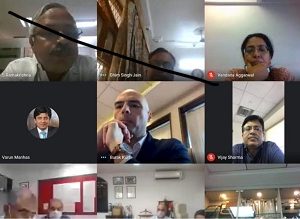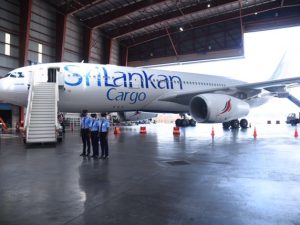In India 60 per cent transportation was by road where as it is much more by waterways in other countries. At the webinar held by Domestic Air Cargo Agents Association of India (DACAAI), Suman P Singh, Joint Secretary – Logistics, MoRTH informs, “We are working on 35 Multimodal Logistic Parks with connectivity of rail, road, air and sea to reduce freight charges and handling charges.” He continues, “Our warehouses have to be bigger and mechanised in order to attain economies of scale. On procedural part, ministry is working on fully automated multimodal logistic parks in paperless mode.” “The multimodal parks at Chennai, Nagpur & Aizwal are getting operational,” Singh informs.
Read More »Delhi NCR sees 45% CAGR growth in warehousing transactions from FY 2017-20
According to India Warehousing Market Report 2020 by Knight Frank, “National Capital Region (NCR) emerges as the foremost market recording the highest volume of leasing at 8.6 million square feet (mn sq ft). It also recorded a 45 per cent CAGR growth in demand over a three year period. The report also notes that an additional 193 mn sq ft of warehousing space can be built on the existing land committed to warehousing across the top 8 cities of India. This works out to a 63 per cent addition to the existing 307 mn sq ft of warehousing stock in these markets NCR has a development potential multiple of 1.75, which implies that 75 per cent more warehousing space, can be added to the region. The current stock is reported to be 57mn sq ft with a potential of expansion to 100mn sq ft on warehousing land of 4,178 acres in NCR. In FY2020, 28 per cent of the warehousing space was leased by e-commerce followed by the manufacturing sector (24 per cent). Major occupiers such as Flipkart and Amazon took up warehouses at the exit points of the Kundli Manesar Palwal Expressway (KMP). The compounded annual growth rate (CAGR) for warehousing transactions for the period FY2017-20 in NCR remained positive with 45 per cent. The warehousing demand in the NCR market has kept vacancy levels low at 13.9 per cent compared to other markets such as Bengaluru and Pune which have vacancy levels of 29.7 per cent and 21.8 per cent respectively.
Read More »Bringing ATF under GST would reduce 40% of the operating cost: Vandana Aggarwal, MoCA
In order to reduce the logistics cost of air carriage, Vandana Aggarwal, Sr Economic Advisor, Ministry of Civil aviation (MoCA), requested Nitin Gadkari, Minister of Road Transport, Highways and MSME, at the webinar held by Domestic Air Cargo Agents Association of India (DACAAI), to recommend to bring air turbine fuel (ATF) under the ambit of the goods and services tax (GST). She informs fuel accounts for 40 per cent cost of aircraft operation. Bringing fuel in the GST regime will reduce the logistics cost of air carriage considerably. MoCA has facilitated the cargo operators in addressing the inter-ministerial issues. “MoCA had also operationalised Air Cargo Community System (ACCS) for all stakeholders to get them into paperless mode which will also reduce costs,” she adds.
Read More »Delhi Airport introduces e-Gate pass at cargo terminal in collaboration with DCBA
Delhi International Airport (DIAL) in collaboration with Delhi Customs Brokers Association (DCBA) and operators of both the cargo terminals (Celebi and DCSC) has launched paperless e-Gate pass with QR coding at their cargo terminals. The e-Gate pass facility would be open to all stake holders effective July 1 as an optional service and it will be made compulsory from July 15. The e-Gate pass facility for import cargo delivery will not only help in ensuring social distancing by reducing human contact at the terminals, but will also expedite the process and save time. The airlines, consolidators or freight forwarders will now upload the scanned copy of Master Airway Bill/ House Airway Bill in the custodian system. The Bill of Entry (BoE) and Out of Charge (OoC) is being transmitted electronically by the Customs to the custodian system. With these details, the custom broker agent will submit the request for issuance of e-gate pass for the delivery of goods and will generate the QR code at his office itself after due verification by the cargo terminal operator, saving time and resources.
Read More »Holisol adds Automated Sales Centre (ASC) to enable faster fulfillment capabilities
Facilitating omnichannel e-commerce, Holisol has scaled up the fulfillment capabilities by adding self-serving ‘Automated Sales Centre (ASC)’, a tech-based solution that enables 24×7 touch-less buying of product. Along with this, the company has created a strong and tech-enabled network of pick-up centres, customer experience centres, rapid fulfilment centres, return/refurbishment centres, dark Stores, exchange stores, omni-channel fulfilment centres and collection centres enabling seamless omnichannel shopping experience for the end customer. “Our focus is, how to increase the accessibility of the consumption market for the customers, especially during the crisis. By enabling distributed inventory model and placing them closer to the consumption market, we aim to make our customers’ supply chain responsive and enable faster fulfilment”, states Rahul S Dogar, Managing Director, Holisol. “The biggest value addition has been to let our customer focus on sourcing and selling, leaving all else in between to us. With our tech-enabled omnichannel network we will speed up the fulfilment including instant, same day or next day fulfilment to increase the sales throughput of our customers,” he adds.
Read More »FarEye partners with Blue Yonder to bring real-time visibility in supply chain
FarEye has announced partnership with Blue Yonder to drive seamless interoperability between legacy infrastructure and modern supply chain and logistics tools. The joint capabilities of both organisations will bring predictive and real-time visibility to supply chains across manufacturing, retail distribution, logistics, and ecommerce. The joint solution can be accessed through Blue Yonder’s LuminateTM Platform. The Luminate Platform combines rich internal and external data from across a customer’s digital supply chain assets to allow for smarter, more actionable Artificial Intelligence (AI) and Machine Learning (ML) based business decisions. “Globally, approximately 30 per cent of spend on logistics to tackle inefficiencies is creating an opportunity to save US$ 1000 billion. Together, FarEye and Blue Yonder aim to capture this market with their joint offering, which will provide an exceptional customer experience in the last mile,” says Kushal Nahata, CEO, FarEye.
Read More »Unless we reduce the logistics cost, we can’t be competitive in the world: Nitin Gadkari
Emphasising on high logistics cost in India as compared to US and China, Nitin Gadkari, Minister of Road Transport, Highways and MSME, Government of India points to all stakeholders, at the webinar held by Domestic Air Cargo Agents Association of India (DACAAI) , “Unless we reduce this logistics cost, we cannot be competitive in the world. We are working in road sector by creating Delhi-Mumbai express highway wherein work has already started in 32 out of 62 pockets. When ready, the trucks can reach Delhi-Mumbai in just 28 hours instead of 48 hours earlier and they would be able to make 9 trips instead of 4 trips which will bring down the cost. “Movement of agri-horticulture, fruit vegetables, lichees from Bihar, pineapple from Nagaland, oranges from Nagpur, grapes from Nashik, fish, prawns and other perishables is important to increase domestic air cargo volumes. However, it won’t be viable by air unless the airfreight cost and other related handling costs get lowered,” he states. According to him, “Cargo operators should work out full cargo flights for fruit and vegetables to get the best rates from airlines. Even old disused aircraft with defence and can be converted to freighters. By using domestic air carriage of perishables farmers can get the all India market and fair value for his produce as well as operators can get profits.”
Read More »3rd edition of CargoTalk digital conclave to be held on Tuesday, July 7
After receiving an overwhelming response in its first two digital conclave, CargoTalk is back with its third conclave on July 7, 2020 from 10 am to 12:15 pm. The virtual summit is divided into two one-hour sessions and will have eminent speakers from trade. The summit will focus on the how digitsation has helped air cargo industry to sustain in the business during the Covid-19 pandemic in these grim times. And, Covid-19 impact on road logistics, especially with the rise in freight rate as most of the trucks still stranded. Speakers will include Saurabh Kumar, CEO, GMR Hyderabad Air Cargo, Amar More, Director, Kale Logistics Solutions, Keku Gazder, CEO, AAICLAS, Chander Agarwal, Managing Director, TCI Express, Ashok Goyal, Managing Director, BLR Logistics and Aditya Shah, Executive Director, V-Trans India.
Read More »SriLankan Airlines convert passenger aircraft to freighter with payload of 45 metric tonnes
SriLankan Airlines has converted a wide-body passenger aircraft into a dedicated cargo aircraft to support country’s export industries and to keep the country connected with the global economy during the pandemic. The aircraft will fly a total of 170 cubic metres of cargo capacity with the enhanced 60 cubic metres of cargo on its upper deck with 110 cubic metres carried on the lower deck. The total payload of the aircraft will amount 45 metric tonns. The converted A330 aircraft has commenced operations from June 25 to key destinations in the Far East and Europe. Chamara Ranasinghe, Head – Cargo, SriLankan Airlines, said, “With the poor demand for passenger travel and the consequent reduction of air freight capacity in the global market has left a significant void for global supply chains. The past few months have seen SriLankan Airlines operating several routes specifically to cater to this demand for cargo capacity with our fleet of passenger aircraft. The converted operation comes at an ideal time for providing customers with enhanced volume capacity in maximizing the connectivity per flight.” Ashok Pathirage, Chairman, SriLankan Airlines said, “We have transformed this aircraft to allow maximum cargo capacity with main deck loading in addition to the aircraft’s lower deck cargo hold to mainly support the needs of our export industries, as well as our imports sector, during the current global shortage of air cargo capacity and to strengthen the airline’s revenue stream during a time when the air transport industry is in crisis.” The reconfiguration of the aircraft was carried out in-house at the airline’s hub at Bandaranaike International Airport, where the SriLankan Airlines’ engineering team worked around the clock. The new operational configuration …
Read More »SAL launches pharma facilities with 14,000 tonnes per year capacity at KFIA
Saudi Arabian Logistics (SAL) has launched the operations of its state-of-the-art pharma facilities recently opened at the King Fahd International Airport’s Cargo Village in Dammam. The new warehouses will support the infrastructure of pharma and medical equipment handling facilities as per the international standards of the World Health Organization (WHO), the European Union Good Distribution Practice and Saudi Food and Drug Authority (SFDA). Before the expansion, the total area of the medical storage facilities stood at 118 square meters but after expansion, it reached 542 square meters with an operational capacity of 14,000 tonnes a year as follows: 262 square meters of the facilities are dedicated for storing goods with temperature ranging between 15-25 celsius whereas 262 square meters are used for storing goods with a temperature between 2-8 celsius. The facilities can also be used for storing different types of medical cargos with very low temperatures, below zero. Omar Hariri, CEO, SAL, says “We usher in a new phase of advanced cargo handling services for pharma and medical equipment. We are creating the proper environment and developing the infrastructure needed for the current period, which has seen an increasing demand for pharma and medical equipment cargos during the Covid-19 pandemic.”
Read More » Cargo Breaking News
Cargo Breaking News









